Covid cases among teenagers and young adults fell in England last week despite the country’s outbreak ticking upwards slightly, official data revealed today.
Public Health England’s weekly surveillance report showed infection rates, the number of positive tests for every 100,000 people, was highest among twenty-somethings. But the figure dropped by 11 per cent to 610.3 for the seven-day spell ending August 15.
Case rates also fell on the week before among adults in their thirties (by 2.9 per cent, to 388.5) and 10-19 year olds (by 1.3 per cent, to 460.7).
Figures rose in every other age group, with the biggest jump seen among adults in their seventies and eighties — the age groups most vulnerable to the virus.
Separate PHE statistics today revealed that Covid outbreaks grew in almost half of England’s 149 local authorities.
The Isle of Wight saw the biggest jump in cases (by 157.5 per cent, to 412.5), followed by Herefordshire (by 109.8 per cent, to 288.2) and Shropshire (by 49.1 per cent, to 315.3).
Meanwhile, data showed rates fell the quickest in Middlesbrough, Bournemouth, Plymouth, Stockton-on-Tees and Sheffield.
But separate surveillance data — published by a major symptom-tracking app — suggested the number of people falling ill with Covid across Britain has fallen slightly in the past week.
There were nearly 44,000 new daily symptomatic cases of the virus in the UK on average by August 14, King’s College London estimates, which was down about 5 per cent on the previous week.
Professor Tim Spector, an epidemiologist and lead scientist on the study, said cases were still ‘stubbornly high’ and warned of a further spike when schools go back in the coming weeks. He said that, depending on how big that spike is, it will likely reignite the debate about whether to vaccinate more children.
Data from the NHS Test and Trace, meanwhile, found the opposite trend, noting a 6 per cent rise in infections in the week to August 11 in England.
This is more in line with the national picture. The Government’s Covid dashboard shows there are about 30,000 new positive tests every day across the UK currently and cases are rising by 7 per cent every week.
Cases have remained high – helped by the ultra-infectious Delta variant blunting vaccines’ effect on transmission – but hospital admissions and deaths remain low thanks to the roll-out.
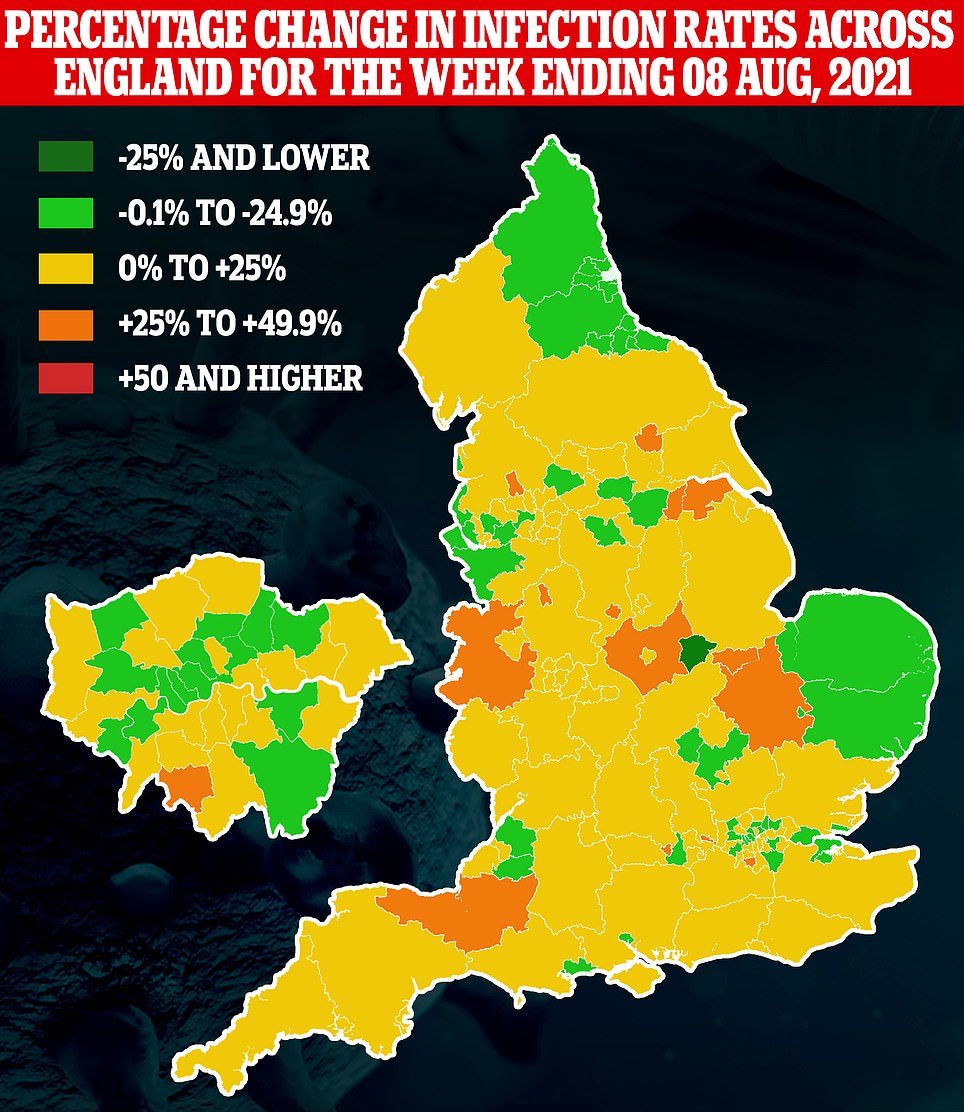
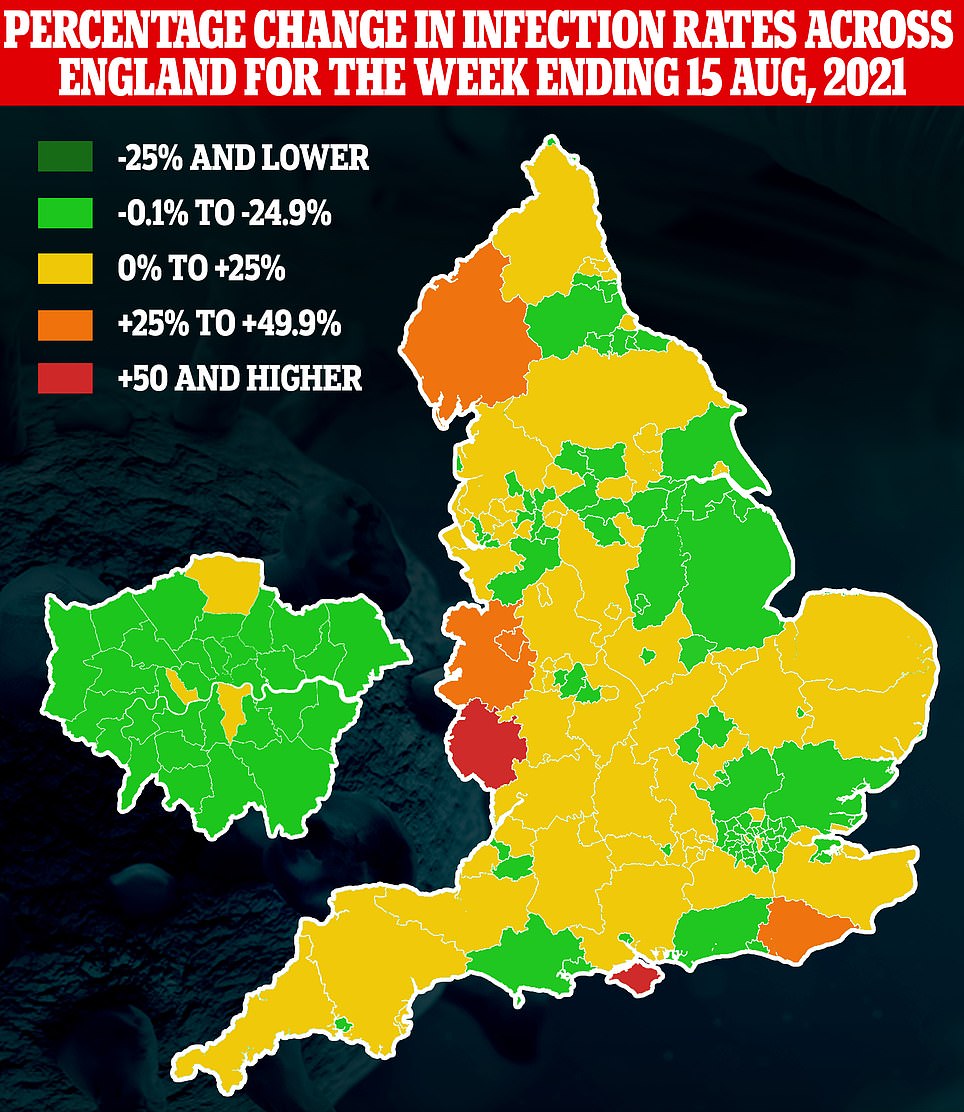 ‹ Slide me ›
‹ Slide me ›
Separate PHE statistics today revealed that Covid outbreaks grew in almost half of England’s 149 local authorities. The Isle of Wight saw the biggest jump in cases (by 157.5 per cent, to 412.5), followed by Herefordshire (by 109.8 per cent, to 288.2) and Shropshire (by 49.1 per cent, to 315.3)
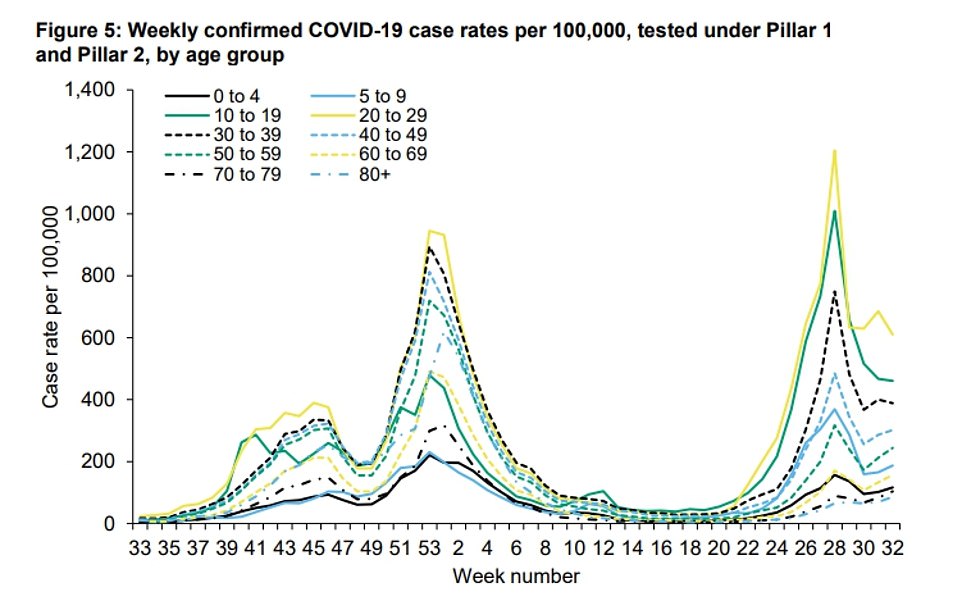
Public Health England’s weekly surveillance report showed infection rates, the number of positive tests for every 100,000 people, was highest among twenty-somethings. But the figure dropped by 11 per cent to 610.3 for the seven-day spell ending August 15. Case rates also fell among adults in their thirties (by 2.9 per cent, to 388.5) and 10-19 year olds (by 1.3 per cent, to 460.7)
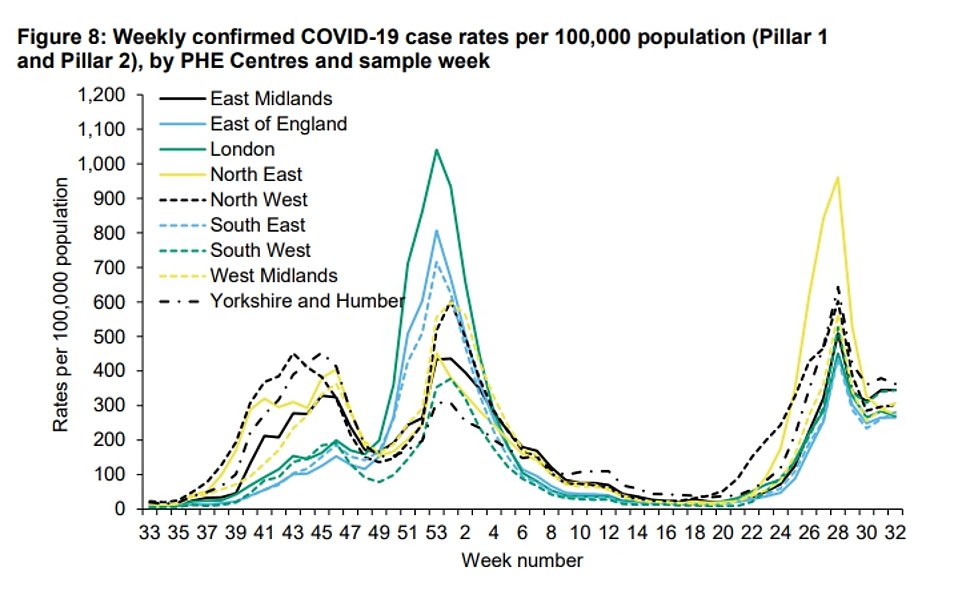
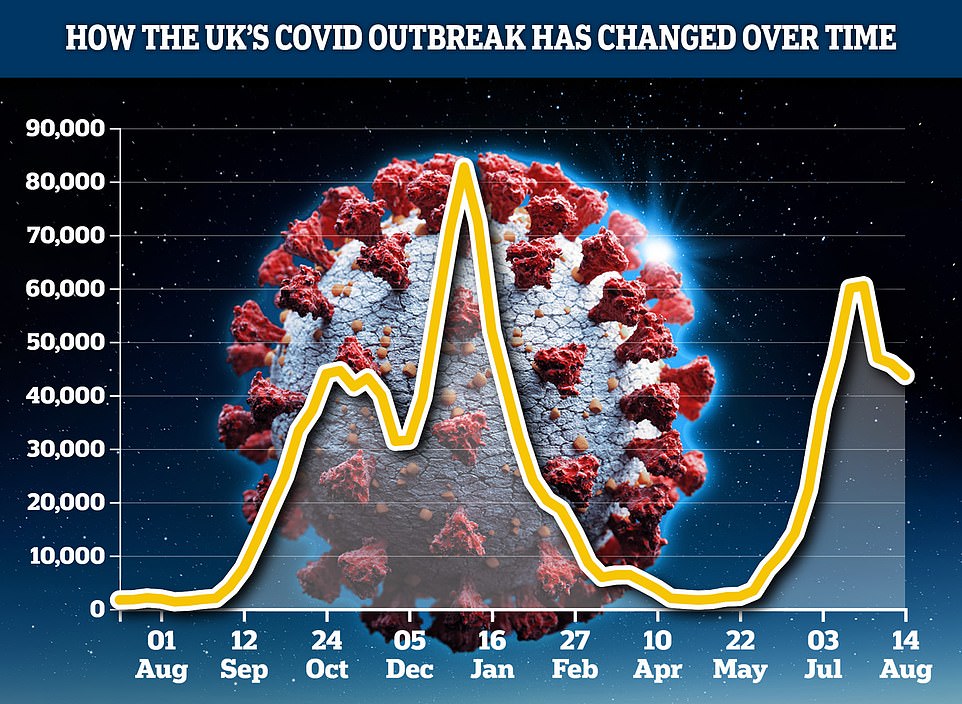
There were nearly 44,000 new daily symptomatic cases of the virus in the UK on average by August 14, King’s College London estimates, which was down about 5 per cent on the previous week

Data from the NHS Test and Trace found almost the exact opposite trend, noting a 6 per cent rise in Covid infections in the past week with about 190,000 in the week to August 11 in England

Meanwhile, data today laid bare how people have started to delete the NHS Covid app following the ‘pingdemic’ chaos. The number of people ‘pinged’ was down nearly a fifth by the same date — even though cases had risen in the same seven-day spell and that Test and Trace was given more contacts to chase. In the week to August 11, there were 753,791 people isolating in England. Broken down 255,474 were isolating after being ‘pinged’ by the NHS app, 307,809 were contacted by NHS Test and Trace and 190,508 were the result of a positive test

Dr William Welfare, PHE’s Covid incident director, said: ‘Case rates remain high across the country.
‘The pandemic is not over but vaccination is weakening the link between infection and serious illness. 16 and 17 year olds can now join the millions who’ve already received their vaccine – we encourage young people to take up this offer as soon as they are able.
‘If you are a contact of a confirmed case and have had both doses of the vaccine, you no longer need to isolate unless you have symptoms.
‘However, you should still get a PCR test, and consider limiting socialising, wearing a mask in crowded places, limiting contact with vulnerable people and continue regular LFD testing.’
PHE’s report is based on positive tests, meaning it only reflects people coming forward for swabs. Not everyone who is infected wants to get tested.
The symptom-tracking study, however, relies on people self-reporting Covid symptoms. Some experts argue it’s becoming a less reliable method now that the Delta strain has become dominant.
Unlike earlier versions of the virus, the variant causes illness similar to other respiratory infections, making it increasingly difficult to distinguish.
Professor Spector said: ‘Daily cases of Covid remain stubbornly high but it’s reassuring to see that unlike in previous waves, these rates aren’t yet translating into high numbers of hospitalisations and deaths. However, seeing what is happening with increasing deaths in Israel we need to be vigilant.
Israel ushers in Covid passports as country ‘wars’ with Delta variant 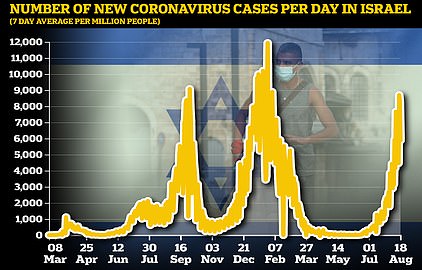
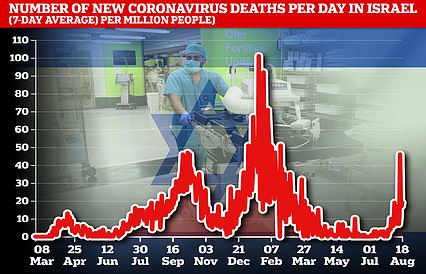
Covid restrictions have been extended to three-year-olds in Israel, where Covid cases and deaths are surging.
From today, everyone aged over three in the country must show evidence of vaccination or a negative test before entering places such as restaurants, cafes, gyms and museums.
The country is in the midst of a third wave despite high vaccination uptake, with one of the country’s top coronavirus experts warning Israel is ‘at war’ with the dominant Delta variant.
Cases reached a six-month high of 8,752 on Monday before falling slightly on Tuesday.
And fatalities are also rising exponentially, with 120 people dying with the virus in the last week – more double the number of people who died in July.
Now the country has brought in stringent Covid restrictions for youngsters in an attempt to control the third wave.
Until today, only over-12s were required to show proof they were double-jabbed two weeks earlier, or a negative Covid test from the last 24 hours before entering public indoor spaces.
Advertisement
‘Whilst vaccines have helped to reduce the severity of the disease, this stalling in cases suggests that we’re starting to see the protection provided by vaccines waning, meaning more fully vaccinated people could be infected in the future.
‘With children in Scotland heading back to the classrooms this week, and cases starting to rise again there, we’ll be keeping a close eye on the numbers. As in the past, steep rises in cases have been closely associated with the return to school.
‘Now many more young people have been infected by Covid. We’re hoping this immunity will lead to a lower spike in cases following the summer holidays than in the past.
‘If there is another big wave of infections, it will raise the hotly debated topic of whether we vaccinate more children to try and achieve herd immunity or re-vaccinate older adults whose immunity is waning.’
King’s College London estimated more than 13,000 of the daily symptomatic cases were among fully vaccinated people. The proportion of jabbed people getting Covid will continue to rise as more of the country gets vaccinated.
This is because the vaccines are not perfect and some immunised people still catch the virus. A smaller number fall ill and need hospital care and a tiny proportion die.
Meanwhile, the daily coronavirus updates from the Department of Health do not suggest any slowing down of the crisis yet.
There were another 33,904 positive tests recorded yesterday, up 14.5 per cent on last Wednesday’s figure of 29,612 — despite swabbing levels remaining flat.
It is the third consecutive day that the rolling seven-day average — which offers a more accurate picture over the true state of the crisis because daily counts can fluctuate heavily — has risen.
Meanwhile, hospitalisations and deaths are still creeping upwards. Both measures lag several weeks behind cases because of how long it can take for the infected to become severely ill.
Another 111 fatalities were recorded on Wednesday, up 6.7 per cent on last week. The average daily toll, which hasn’t stood in triple figures since March, is now around 94.
And 773 Covid-infected patients were admitted to NHS hospitals on August 14, the most recent day UK-wide data is available for — up 8.6 per cent on the previous Saturday.
The Government’s weekly Test and Trace report showed a total of 89.2 per cent of people who were tested for Covid-19 in England in the week ending August 11 at a regional site, local site or mobile testing unit received their result within 24 hours. This is up from 84.9 per cent in the previous week.
Prime Minister Boris Johnson had pledged last year for the results of all in-person tests would be back within 24 hours.
He told the House of Commons on June 3 2020 he would get ‘all tests turned around within 24 hours by the end of June, except for difficulties with postal tests or insuperable problems like that’.
Some 13.6 per cent of people – nearly one in seven – who were transferred to Test and Trace in England in the week to August 11 were not reached, meaning they were not able to provide details of recent close contacts.
This is up slightly from 13.2 per cent in the previous week. The percentage of people not reached through Test and Trace has not dropped below 13 per cent since the end of June.
Anybody in England who tests positive for Covid-19, either through a rapid (LFD) test or a PCR test processed in a laboratory, is transferred to Test and Trace so their contacts can be identified and alerted.
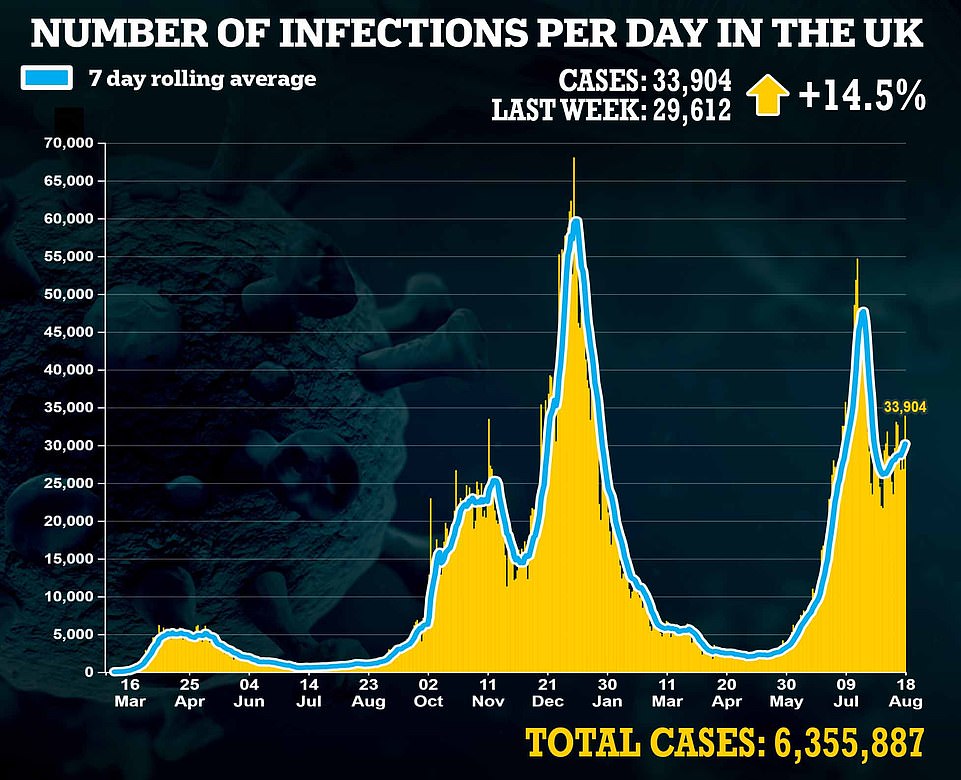
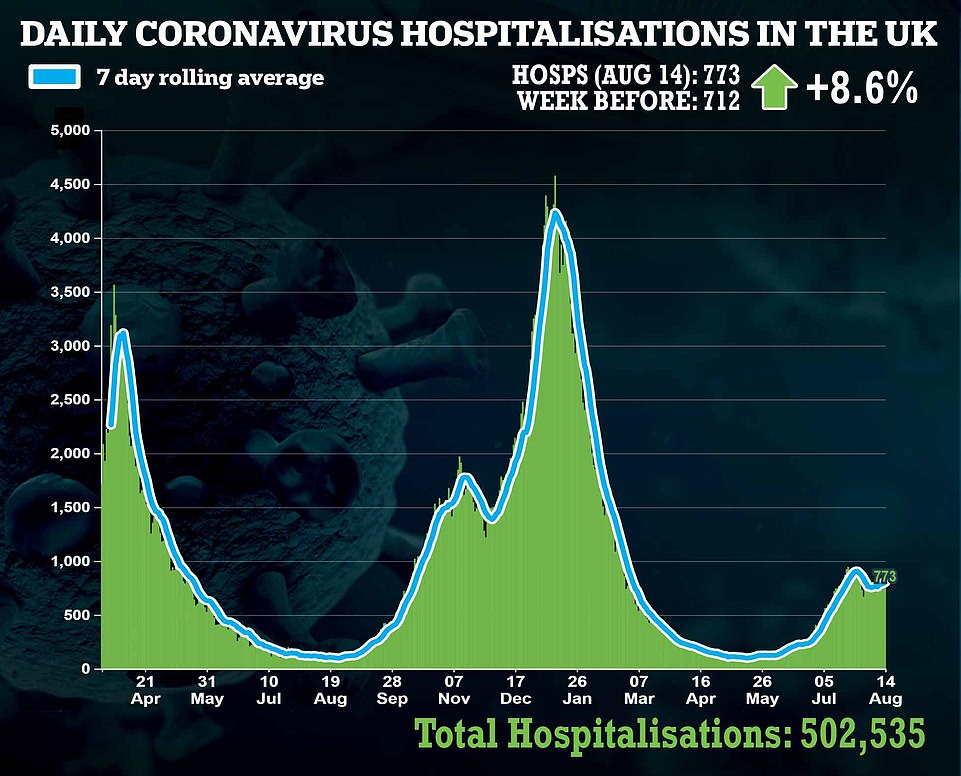
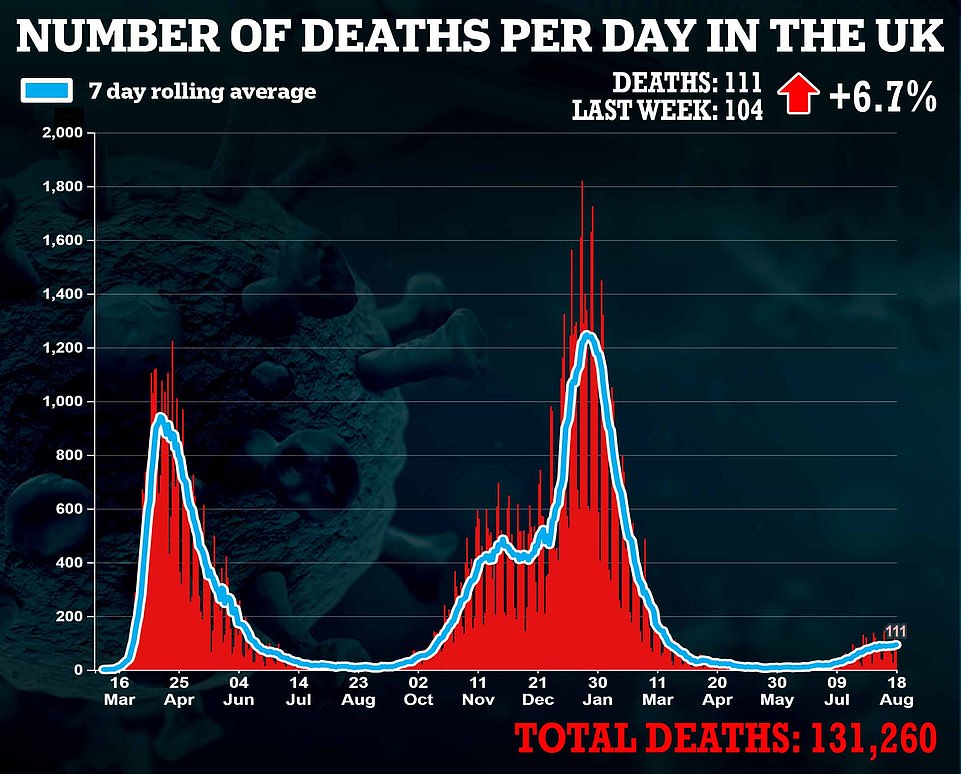
It comes after a major study found double-jabbed people who catch the Indian variant are just as likely to develop symptoms and spread Covid as the unvaccinated.
The Oxford University research suggests herd immunity is ‘unachievable’ because vaccines do not significantly reduce transmission of the virus.
Although fully vaccinated people are significantly less likely to be infected, those who do get Covid have a similar peak ‘viral load’ as the unvaccinated.
This means infected people ‘shed’ the same amount of virus when they cough or sneeze, regardless of whether or not they have been jabbed.
Experts said the findings strengthened the argument for a ‘booster’ Covid jab programme this autumn. However, the study stressed that two doses remain remarkably effective at preventing death and hospitalisation.
And even though the viral load may peak at similar levels in the vaccinated and unvaccinated, scientists say it’s possible jabbed people clear the infection quicker.
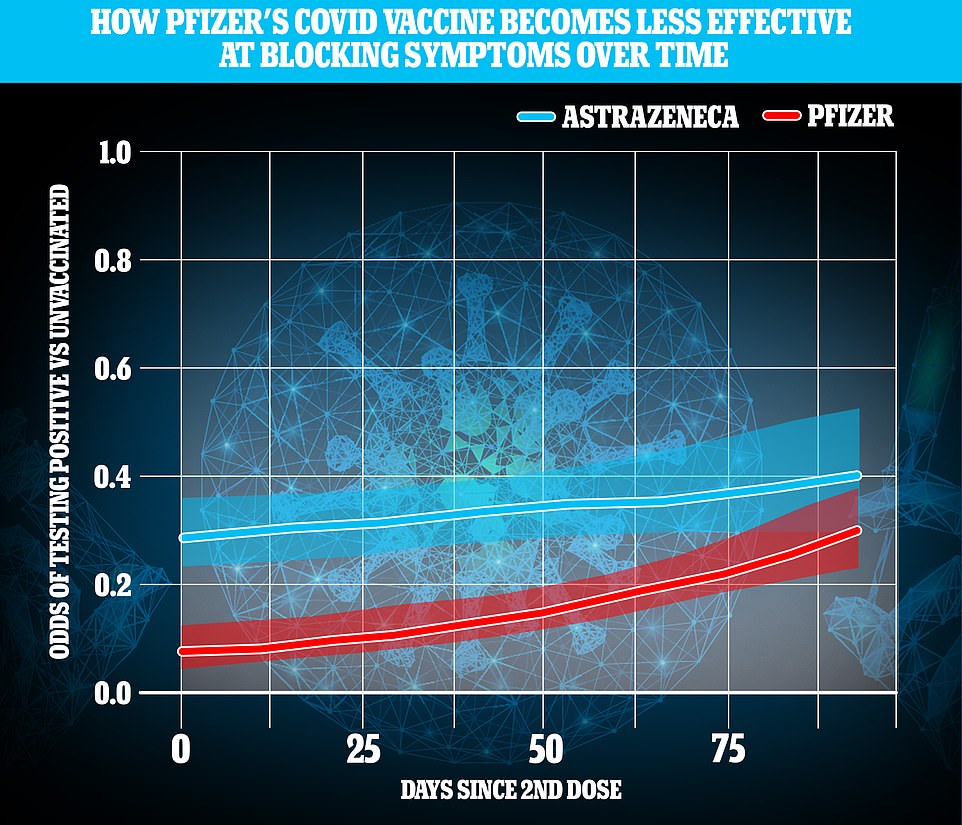
The study found that people who catch the Indian variant are just as likely to develop symptoms and spread Covid as the unvaccinated. But those who are doubled jabbed are still significantly less likely to catch it in the first place. The chart above shows how Pfizer’s (in red) reduces the risk by about 80 per cent – shown as an odds ratio of 0.2 – and AstraZeneca’s cuts the risk by more than 65 per cent, shown as an odds ratio of around 0.4

The risk of catching the virus is broken down by age group and vaccine type, with red and green showing Pfizer and blue and purple representing AstraZeneca. Note: The figures will be slightly skewed by the fact AstraZeneca’s jab has not been given to adults under 40 because of blood clot fears. The charts show the vaccines work better on younger people than older people
It follows similar findings by Public Health England and the US’ Center for Disease Control and Prevention (CDC), which earlier this month released figures showing unvaccinated and double-jabbed have very similar viral loads.
The Oxford study, based on data from 700,000 Britons, is the largest yet to evaluate vaccine effectiveness against the Delta variant, which has been dominant in the UK since May.
Researchers concluded two doses reduce the chance of getting Covid by about 82 per cent for Pfizer and 67 per cent for AstraZeneca.
Although Pfizer initially has greater effectiveness against Delta, this declines more quickly and after four to five months both vaccines offer similar levels of protection, the researchers claimed. They did not say what level of protection this amounted to.
Source link : https://www.dailymail.co.uk/news/article-9908727/Covid-cases-fell-week-adults-20s-30s-10-19-year-olds.html











